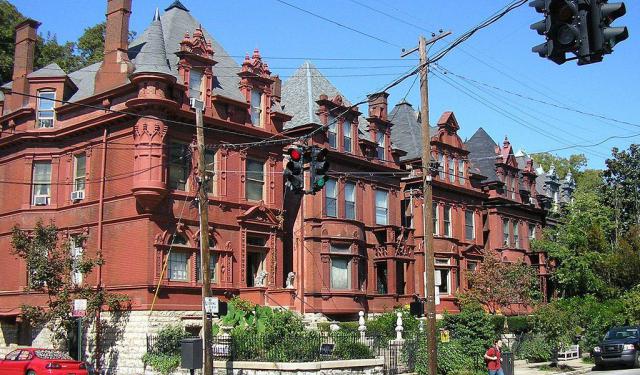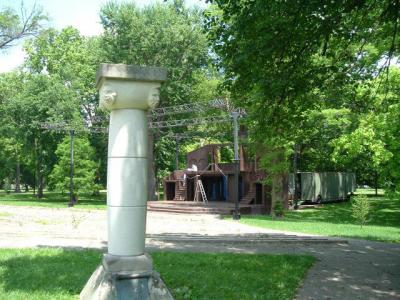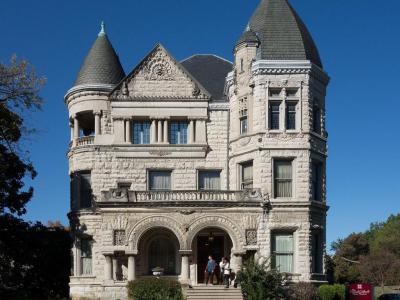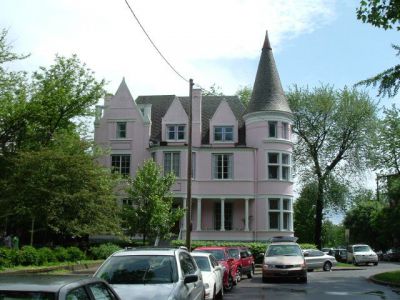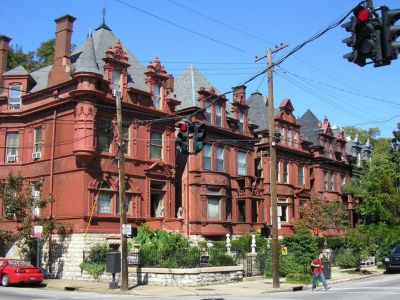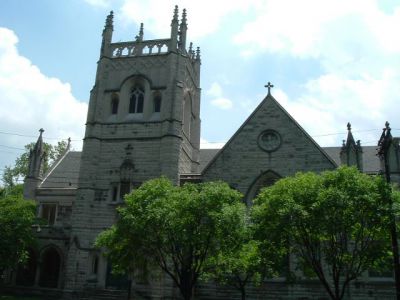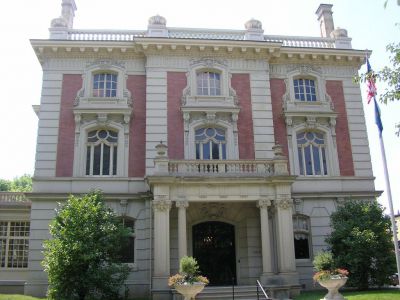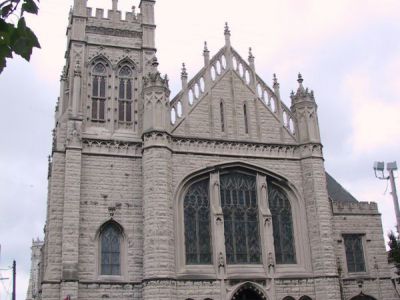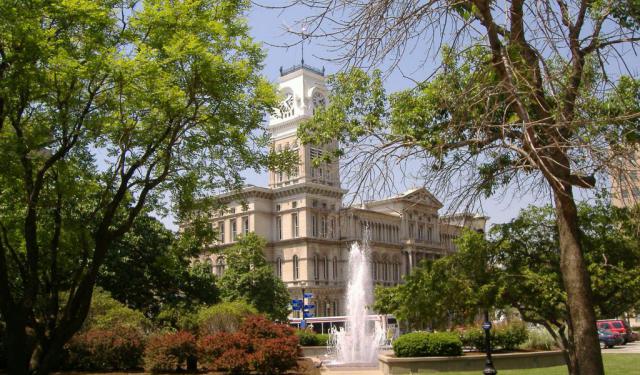Historical Old Louisville Walking Tour (Self Guided), Louisville
The third largest urban district in the United States and the country's largest preservation district of Victorian-era buildings, the Old Town of Louisville is an ideal area in which to travel through the city's history. It is here that Louisville's oldest and most peculiar houses and other reminders of the past are concentrated, featuring a wealth of architectural styles.
Central Park, located in the heart of Old Louisville, offers green spaces for relaxation and community events. One notable gem in the vicinity is the Conrad-Caldwell House, a notable example of Richardsonian Romanesque architecture. Nearby, Saint James Court, part of the historic Saint James–Belgravia District, is a model of thoughtful urban planning, featuring picturesque Victorian homes surrounding a beautiful fountain, creating a quintessential Southern ambiance.
The Pink Palace, with its distinctive pink façade, adds a touch of whimsy to the area. Werne's Row showcases row houses that date back to the late 1800s, distinguished from each other by subtle ornamental details, with the original private park.
The West End Baptist Church and Fourth Avenue United Methodist Church are both notable religious landmarks, each with its unique architectural style and historical significance. For those interested in delving deeper into the area's history, the Filson Historical Society provides a wealth of information and resources.
If you're ever in Louisville, don't miss the chance to explore its Old Town. With its charming parks and majestic historic homes, this part of the city can equally attract a history enthusiast, architecture buff, or anyone looking for a peaceful stroll, whilst admiring beautiful surroundings. So, come and explore these and other interesting facets of Old Louisville, whenever you can, on this self-guided walk.
Central Park, located in the heart of Old Louisville, offers green spaces for relaxation and community events. One notable gem in the vicinity is the Conrad-Caldwell House, a notable example of Richardsonian Romanesque architecture. Nearby, Saint James Court, part of the historic Saint James–Belgravia District, is a model of thoughtful urban planning, featuring picturesque Victorian homes surrounding a beautiful fountain, creating a quintessential Southern ambiance.
The Pink Palace, with its distinctive pink façade, adds a touch of whimsy to the area. Werne's Row showcases row houses that date back to the late 1800s, distinguished from each other by subtle ornamental details, with the original private park.
The West End Baptist Church and Fourth Avenue United Methodist Church are both notable religious landmarks, each with its unique architectural style and historical significance. For those interested in delving deeper into the area's history, the Filson Historical Society provides a wealth of information and resources.
If you're ever in Louisville, don't miss the chance to explore its Old Town. With its charming parks and majestic historic homes, this part of the city can equally attract a history enthusiast, architecture buff, or anyone looking for a peaceful stroll, whilst admiring beautiful surroundings. So, come and explore these and other interesting facets of Old Louisville, whenever you can, on this self-guided walk.
How it works: Download the app "GPSmyCity: Walks in 1K+ Cities" from Apple App Store or Google Play Store to your mobile phone or tablet. The app turns your mobile device into a personal tour guide and its built-in GPS navigation functions guide you from one tour stop to next. The app works offline, so no data plan is needed when traveling abroad.
Historical Old Louisville Walking Tour Map
Guide Name: Historical Old Louisville Walking Tour
Guide Location: USA » Louisville (See other walking tours in Louisville)
Guide Type: Self-guided Walking Tour (Sightseeing)
# of Attractions: 8
Tour Duration: 1 Hour(s)
Travel Distance: 2.2 Km or 1.4 Miles
Author: Cathy
Sight(s) Featured in This Guide:
Guide Location: USA » Louisville (See other walking tours in Louisville)
Guide Type: Self-guided Walking Tour (Sightseeing)
# of Attractions: 8
Tour Duration: 1 Hour(s)
Travel Distance: 2.2 Km or 1.4 Miles
Author: Cathy
Sight(s) Featured in This Guide:
- Central Park
- Conrad-Caldwell House
- Saint James Court
- Pink Palace
- Werne's Row
- West End Baptist Church
- Filson Historical Society
- Fourth Avenue United Methodist Church
1) Central Park
Central Park, nestled in the heart of Old Louisville, carries a rich legacy that blends Southern charm with cultural innovation. Originally the private estate of the DuPont family, the grounds played a prominent role in the late 19th century as the site of the Southern Exposition, an industrial fair that once featured one of the earliest large-scale public displays of Thomas Edison’s incandescent light bulb. For a brief period, the park was enclosed to host the exposition, featuring an electric trolley, roller coaster, lakefront art museum, and bike paths.
By the early 20th century, the DuPont family had opened their front lawn to the public, laying the foundation for what would become Central Park. In 1901, famed landscape architect Frederick Law Olmsted was commissioned to reimagine the site. His design preserved the original exposition of walking trails and introduced athletic fields, a wading pool, and a thoughtfully landscaped layout that remains largely intact today. The transformation culminated in 1905 with the demolition of the DuPont mansion and the park’s full conversion into a public green space.
Over time, Central Park evolved into one of Louisville’s most beloved cultural and recreational hubs. It is home to the C. Douglass Ramey Amphitheater, which hosts the long-running Kentucky Shakespeare Festival, and forms part of the northern section of the popular Saint James Court Art Show. The Old Louisville Visitors Center, located within the park, offers educational programs and serves as a community gathering space.
Today, Central Park continues to thrive as a venue for both leisure and lively events. Its shaded trails, tennis courts, sprayground, and open lawns attract daily visitors, while seasonal festivities like Old Louisville LIVE, Jazz in Central Park, and Victorian Tales of Terror add to its year-round appeal. True to its Olmstedian roots, the park remains a space for both quiet reflection and dynamic public life.
By the early 20th century, the DuPont family had opened their front lawn to the public, laying the foundation for what would become Central Park. In 1901, famed landscape architect Frederick Law Olmsted was commissioned to reimagine the site. His design preserved the original exposition of walking trails and introduced athletic fields, a wading pool, and a thoughtfully landscaped layout that remains largely intact today. The transformation culminated in 1905 with the demolition of the DuPont mansion and the park’s full conversion into a public green space.
Over time, Central Park evolved into one of Louisville’s most beloved cultural and recreational hubs. It is home to the C. Douglass Ramey Amphitheater, which hosts the long-running Kentucky Shakespeare Festival, and forms part of the northern section of the popular Saint James Court Art Show. The Old Louisville Visitors Center, located within the park, offers educational programs and serves as a community gathering space.
Today, Central Park continues to thrive as a venue for both leisure and lively events. Its shaded trails, tennis courts, sprayground, and open lawns attract daily visitors, while seasonal festivities like Old Louisville LIVE, Jazz in Central Park, and Victorian Tales of Terror add to its year-round appeal. True to its Olmstedian roots, the park remains a space for both quiet reflection and dynamic public life.
2) Conrad-Caldwell House (must see)
The Conrad-Caldwell House, or Conrad's Castle, is a historic, Victorian mansion set in the heart of Old Louisville, on Saint James Court. Today it serves as a museum. Commissioned by Theophilus Conrad, a rich local businessman, the house was built by famed Louisville architect, Arthur Loomis, in 1895. Boasting a striking Richardsonian Romanesque exterior, the castle-like structure is one of the finest examples of this architectural style and symbolizes the progressive spirit and Victorian grandeur of Louisville’s Gilded Age.
Surrounded by a beautiful courtyard neighborhood, Conrad's Castle featured all the latest innovations of its day, including interior plumbing and electric lighting. Known for its beautiful woodwork and parquet floors, this massive Bedford limestone home, covered with gargoyles, beautiful archways, and elaborate stone designs, incorporated seven types of hardwoods and magnificent stained glass windows in the interior design, making it one of the most stunning dwellings in Old Louisville.
After the owner's death, the mansion was bought by the Caldwell family who lived here for 35 years. After the Caldwells, the house was used as a shelter for the Rose Anna Hughes Presbyterian Retirement Home. Currently a museum, its Victorian interiors are lovingly restored and preserved, featuring a wealth of period items, including many original pieces belonging to both families.
Why You Should Visit:
A site of cultural and architectural significance in Louisville, a standing testament to the abundant lifestyle of the owners, Theophile Conrad and William E. Caldwell, two of Louisville's most prominent businessmen and entrepreneurs.
A distinguishing marker in America’s largest concentration of Victorian homes.
A step back in time enabling to learn more about the era and the neighborhood.
Tip:
Guided tours of the museum are run on a “first come – first served” basis; no reservations accepted for groups less than 10. Advanced reservations are necessary for groups of 10 or more. Tickets can be purchased in advance at the door, 30 minutes prior to each tour. Children aged under 5 enter free of charge. On the third Thursday of every month, the museum offers extended times, at 5pm & 7pm, for its third Thursday Twilight Tours. The tours last from 60-90 minutes. Donations are greatly appreciated.
Surrounded by a beautiful courtyard neighborhood, Conrad's Castle featured all the latest innovations of its day, including interior plumbing and electric lighting. Known for its beautiful woodwork and parquet floors, this massive Bedford limestone home, covered with gargoyles, beautiful archways, and elaborate stone designs, incorporated seven types of hardwoods and magnificent stained glass windows in the interior design, making it one of the most stunning dwellings in Old Louisville.
After the owner's death, the mansion was bought by the Caldwell family who lived here for 35 years. After the Caldwells, the house was used as a shelter for the Rose Anna Hughes Presbyterian Retirement Home. Currently a museum, its Victorian interiors are lovingly restored and preserved, featuring a wealth of period items, including many original pieces belonging to both families.
Why You Should Visit:
A site of cultural and architectural significance in Louisville, a standing testament to the abundant lifestyle of the owners, Theophile Conrad and William E. Caldwell, two of Louisville's most prominent businessmen and entrepreneurs.
A distinguishing marker in America’s largest concentration of Victorian homes.
A step back in time enabling to learn more about the era and the neighborhood.
Tip:
Guided tours of the museum are run on a “first come – first served” basis; no reservations accepted for groups less than 10. Advanced reservations are necessary for groups of 10 or more. Tickets can be purchased in advance at the door, 30 minutes prior to each tour. Children aged under 5 enter free of charge. On the third Thursday of every month, the museum offers extended times, at 5pm & 7pm, for its third Thursday Twilight Tours. The tours last from 60-90 minutes. Donations are greatly appreciated.
3) Saint James Court
Saint James Court is a defining feature of Old Louisville and forms the northern section of the Saint James–Belgravia Historic District. Once the site of the Southern Exposition (1883–1887), the area was a stage for innovation and spectacle. Thomas Edison famously illuminated the fairgrounds with what was then the largest electric lighting display outside New York, while the electric trolley made its dazzling debut. The Exposition left its mark not just in memory but in the shape of the neighborhood that followed.
After the Exposition concluded, the land was transformed into one of Louisville’s earliest examples of planned urban design. Rather than fronting busy streets, homes along Saint James Court were oriented toward a green pedestrian mall. This thoughtful layout-along with Belgravia and Fountain Courts-set a precedent for city development and contributed to the neighborhood’s enduring charm. Grand Victorian mansions now flank Saint James Court, their facades facing a landscaped oval dotted with mature trees and centered around an ornate bronze fountain. Gas lamps still flicker at night, preserving an air of calm elegance.
The court reaches peak vibrancy every October during the Saint James Court Art Show. One of the nation’s largest open-air art fairs, the event draws hundreds of artists and craftsmen and attracts crowds in the hundreds of thousands. For three days, the shaded green promenade is transformed into a gallery of color, texture, and creativity-set against the backdrop of historic splendor.
In recognition of its architectural and cultural value, the district was listed on the National Register of Historic Places in 1972.
After the Exposition concluded, the land was transformed into one of Louisville’s earliest examples of planned urban design. Rather than fronting busy streets, homes along Saint James Court were oriented toward a green pedestrian mall. This thoughtful layout-along with Belgravia and Fountain Courts-set a precedent for city development and contributed to the neighborhood’s enduring charm. Grand Victorian mansions now flank Saint James Court, their facades facing a landscaped oval dotted with mature trees and centered around an ornate bronze fountain. Gas lamps still flicker at night, preserving an air of calm elegance.
The court reaches peak vibrancy every October during the Saint James Court Art Show. One of the nation’s largest open-air art fairs, the event draws hundreds of artists and craftsmen and attracts crowds in the hundreds of thousands. For three days, the shaded green promenade is transformed into a gallery of color, texture, and creativity-set against the backdrop of historic splendor.
In recognition of its architectural and cultural value, the district was listed on the National Register of Historic Places in 1972.
4) Pink Palace
The Pink Palace is a private residence, one of the most popular in Old Louisville, that sits on the corner of Saint James and Belgravia Courts. This beautiful, pedestrians-only area was developed by William Slaughter, who designed it to resemble the residential parks of London, with a central fountain and esplanade.
The towering house itself was built in 1897, in the style of French palaces featuring details of Ecletic and Chateauesque, to accommodate the gentleman's club and casino. Unfortunately, the club enjoyed the Palace only for a few years before it was sold to a new owner. In 1910, the Woman’s Christian Temperance Union (WCTU) - one of the driving forces behind prohibition - purchased The Pink Palace (a red brick building at the time), unaware of its former life as a brothel. When the history of The Pink Palace was revealed to the WCTU, the women were so embarrassed they decided the only way to wipe the house’s slate clean was to paint it the bright shade of pink which still decorates the walls today. Later, the property was purchased by a family who turned into their home.
Resplendent in its pink glory, for all neighbors to see and for all Saint James Court Art Show patrons to ogle in envy, The Pink Palace nonetheless has the reputation of being haunted. Over 100 years since construction, the surrounding area is still the quiet, beautifully green space, just as William Slaughter intended it to be.
The towering house itself was built in 1897, in the style of French palaces featuring details of Ecletic and Chateauesque, to accommodate the gentleman's club and casino. Unfortunately, the club enjoyed the Palace only for a few years before it was sold to a new owner. In 1910, the Woman’s Christian Temperance Union (WCTU) - one of the driving forces behind prohibition - purchased The Pink Palace (a red brick building at the time), unaware of its former life as a brothel. When the history of The Pink Palace was revealed to the WCTU, the women were so embarrassed they decided the only way to wipe the house’s slate clean was to paint it the bright shade of pink which still decorates the walls today. Later, the property was purchased by a family who turned into their home.
Resplendent in its pink glory, for all neighbors to see and for all Saint James Court Art Show patrons to ogle in envy, The Pink Palace nonetheless has the reputation of being haunted. Over 100 years since construction, the surrounding area is still the quiet, beautifully green space, just as William Slaughter intended it to be.
5) Werne's Row
Werne’s Row is a distinctive ensemble of five Châteauesque mansions located in the heart of Old Louisville. Built in 1897 for Joseph Werne, a well-known jeweler and antiques dealer, the homes were designed by architect F.W. Mowbray, who also created Louisville’s Union Station. These red brick mansions stand just one foot apart but never touch-a detail that adds to their symmetrical yet individualized charm. Their design features classic Château-style elements, while each home has small ornamental differences that set it apart from its neighbors.
Set at the corner of 4th and Hill Streets, Werne’s Row embodies the eclectic spirit of Old Louisville, a neighborhood known for its dense concentration of Victorian architecture and stained-glass windows. While the exterior design was handled by Mowbray, the interiors were created by Claude Balfour, contributing to the refined elegance of the original homes. Joseph Werne and his wife lived in the corner residence, while Dr. William Wathen occupied the blue mansion facing Belgravia Court.
Today, three of the houses have been subdivided into apartments, while the remaining two serve as private single-family residences. Though a private park once stretched behind the row, it has since been converted into parking for the adjacent Belgravia Court Association. Despite these changes, the row maintains its historic visual harmony and remains one of the most photographed features of the district.
Werne’s Row offers a vivid glimpse into Louisville’s architectural past, blending personal history with formal design in one of the city’s most architecturally cohesive blocks.
Set at the corner of 4th and Hill Streets, Werne’s Row embodies the eclectic spirit of Old Louisville, a neighborhood known for its dense concentration of Victorian architecture and stained-glass windows. While the exterior design was handled by Mowbray, the interiors were created by Claude Balfour, contributing to the refined elegance of the original homes. Joseph Werne and his wife lived in the corner residence, while Dr. William Wathen occupied the blue mansion facing Belgravia Court.
Today, three of the houses have been subdivided into apartments, while the remaining two serve as private single-family residences. Though a private park once stretched behind the row, it has since been converted into parking for the adjacent Belgravia Court Association. Despite these changes, the row maintains its historic visual harmony and remains one of the most photographed features of the district.
Werne’s Row offers a vivid glimpse into Louisville’s architectural past, blending personal history with formal design in one of the city’s most architecturally cohesive blocks.
6) West End Baptist Church
West End Baptist Church, originally built as Saint Paul’s Episcopal Church, is one of Old Louisville’s architectural treasures. Designed by renowned architects William J. Dodd and Mason Maury, the building stands as a striking example of the Gothic Revival style. Its most distinctive feature is the imposing square tower, adorned with ornate decorative elements that speak to the craftsmanship and aesthetic ideals of the era. The structure is not only a historical landmark but also a visual anchor in the neighborhood’s richly layered streetscape.
Today, West End Baptist Church serves as a vibrant spiritual home with a deep commitment to inclusivity and outreach. Guided by the teachings of Jesus, the church focuses on ministering to the broken-hearted, hungry, sick, and imprisoned-reflecting a mission rooted in compassion and justice. Worship services are characterized by heartfelt praise and a strong sense of community, welcoming individuals from all walks of life.
Looking toward the future, the church envisions expanding its educational programs, deepening its support for missions, and extending care to the elderly and marginalized. As an African American congregation, West End Baptist Church embraces its leadership role in fostering ministry across cultural lines. With a foundation in Christian stewardship, the church emphasizes the responsible use of resources in service to both God and the community.
In combining historic beauty with a modern mission, West End Baptist Church remains a beacon of hope and faith in Louisville’s west end-where tradition and transformation meet under one towering roof.
Today, West End Baptist Church serves as a vibrant spiritual home with a deep commitment to inclusivity and outreach. Guided by the teachings of Jesus, the church focuses on ministering to the broken-hearted, hungry, sick, and imprisoned-reflecting a mission rooted in compassion and justice. Worship services are characterized by heartfelt praise and a strong sense of community, welcoming individuals from all walks of life.
Looking toward the future, the church envisions expanding its educational programs, deepening its support for missions, and extending care to the elderly and marginalized. As an African American congregation, West End Baptist Church embraces its leadership role in fostering ministry across cultural lines. With a foundation in Christian stewardship, the church emphasizes the responsible use of resources in service to both God and the community.
In combining historic beauty with a modern mission, West End Baptist Church remains a beacon of hope and faith in Louisville’s west end-where tradition and transformation meet under one towering roof.
7) Filson Historical Society
The Filson Historical Society in Louisville is one of the state’s most important repositories of regional history. Originally founded in 1884 as the Filson Club by Col. Reuben T. Durrett and a group of Louisville’s prominent citizens, the society was named in honor of early explorer and historian John Filson, whose 1784 publication helped shape the early identity of Kentucky. The society’s mission was, and remains, to preserve the rich historical record of Kentucky and the Ohio Valley. Among its more curious holdings is a section of beech tree inscribed with the folkloric claim, “D. Boon kilt a bar 1803.”
Following Durrett’s failing health in the 1910s, the society faced a major setback when most of its collection was sold to the University of Chicago. Despite this loss, the Filson steadily rebuilt its archives and now holds an extensive array of over 1.5 million manuscript items, 50,000 library volumes, thousands of artifacts, and a notable collection of regional portraits. These resources are open to the public and continue to support scholarly research, genealogical work, and educational programming.
The Filson has also evolved as a cultural hub, offering lectures, exhibitions, and academic conferences that explore Kentucky’s social, political, and cultural history. Since 1986, its home has been the stately Ferguson Mansion in Old Louisville, a grand structure built between 1901 and 1905, once considered the city’s most lavish private residence.
In 1991, the Society expanded its historical footprint further when Thomas Walker Bullitt donated his family farmhouse and surrounding historic property. Today, the Filson Historical Society stands as both a guardian of the past and a dynamic participant in the intellectual and cultural life of Kentucky.
Following Durrett’s failing health in the 1910s, the society faced a major setback when most of its collection was sold to the University of Chicago. Despite this loss, the Filson steadily rebuilt its archives and now holds an extensive array of over 1.5 million manuscript items, 50,000 library volumes, thousands of artifacts, and a notable collection of regional portraits. These resources are open to the public and continue to support scholarly research, genealogical work, and educational programming.
The Filson has also evolved as a cultural hub, offering lectures, exhibitions, and academic conferences that explore Kentucky’s social, political, and cultural history. Since 1986, its home has been the stately Ferguson Mansion in Old Louisville, a grand structure built between 1901 and 1905, once considered the city’s most lavish private residence.
In 1991, the Society expanded its historical footprint further when Thomas Walker Bullitt donated his family farmhouse and surrounding historic property. Today, the Filson Historical Society stands as both a guardian of the past and a dynamic participant in the intellectual and cultural life of Kentucky.
8) Fourth Avenue United Methodist Church
Fourth Avenue United Methodist Church, located on West Saint Catherine Street in Louisville, Kentucky, traces its roots to 1888 when two congregations-the Walnut Street Methodist Episcopal Church South and the Chestnut Street Church-united to form a new community of worship. The group first bought land at Third and Saint Catherine but soon sold it to build on the current site at Fourth Avenue. The first service was held on December 16, 1888, with 111 charter members and Dr. J. H. Young serving as pastor.
As the congregation grew, plans for a larger sanctuary were set in motion. By January 1902, membership had risen to 472 under the leadership of Dr. H. D. Moore, and construction of the current Gothic Revival-style sanctuary began. The design incorporated elements of the original 1888 building, preserving its historic and architectural value. Recognized for its striking beauty and ecclesiastical design, the sanctuary remains a prominent example of Gothic Revival architecture and was listed on the National Register of Historic Places in 1979.
Over the decades, the church expanded and adapted to the needs of its growing congregation. A Sunday School Annex was added in 1922, and major renovations were undertaken following the devastating 1937 flood. The Sallie Smyser Chapel, completed in 1957, is the most recent addition to the church complex, enhancing its role as both a place of worship and community gathering.
Today, Fourth Avenue United Methodist Church continues its mission as a metropolitan and intercultural congregation, committed to fostering grace, faith, and inclusivity in the heart of Louisville. Through its long-standing presence and architectural grandeur, the church remains a cherished spiritual and historical landmark in the city.
As the congregation grew, plans for a larger sanctuary were set in motion. By January 1902, membership had risen to 472 under the leadership of Dr. H. D. Moore, and construction of the current Gothic Revival-style sanctuary began. The design incorporated elements of the original 1888 building, preserving its historic and architectural value. Recognized for its striking beauty and ecclesiastical design, the sanctuary remains a prominent example of Gothic Revival architecture and was listed on the National Register of Historic Places in 1979.
Over the decades, the church expanded and adapted to the needs of its growing congregation. A Sunday School Annex was added in 1922, and major renovations were undertaken following the devastating 1937 flood. The Sallie Smyser Chapel, completed in 1957, is the most recent addition to the church complex, enhancing its role as both a place of worship and community gathering.
Today, Fourth Avenue United Methodist Church continues its mission as a metropolitan and intercultural congregation, committed to fostering grace, faith, and inclusivity in the heart of Louisville. Through its long-standing presence and architectural grandeur, the church remains a cherished spiritual and historical landmark in the city.
Walking Tours in Louisville, Kentucky
Create Your Own Walk in Louisville
Creating your own self-guided walk in Louisville is easy and fun. Choose the city attractions that you want to see and a walk route map will be created just for you. You can even set your hotel as the start point of the walk.
Louisville Introduction Walking Tour
Poised on the banks of the Ohio River, Kentucky's largest city Louisville blends small-town charm with urban sophistication. The first European settlement in the vicinity of modern-day Louisville was on Corn Island, established in 1778 by Col. George Rogers Clark, credited as the founder of the city. Two years later, the Virginia General Assembly approved the town charter of Louisville. The... view more
Tour Duration: 2 Hour(s)
Travel Distance: 4.5 Km or 2.8 Miles
Tour Duration: 2 Hour(s)
Travel Distance: 4.5 Km or 2.8 Miles
Louisville Architecture Walking Tour
Louisville, Kentucky, is famous for its architectural marvels, featuring a combination of styles and eras, sizes and artistic directions, adding a great deal of uniqueness to the city panorama. Architecture buffs will be delighted at a chance to admire the elaborate edifices abounding the city.
One such iconic spot is Whiskey Row. Once a bustling hub of the local bourbon industry, it has been... view more
Tour Duration: 2 Hour(s)
Travel Distance: 2.8 Km or 1.7 Miles
One such iconic spot is Whiskey Row. Once a bustling hub of the local bourbon industry, it has been... view more
Tour Duration: 2 Hour(s)
Travel Distance: 2.8 Km or 1.7 Miles
The Most Popular Cities
/ view all
